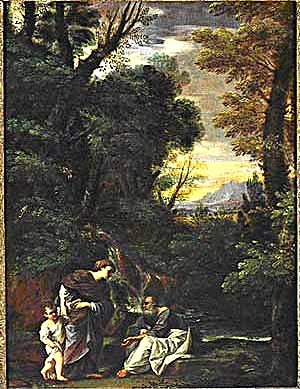Among these paintings are the pendants of the Prophet Elijah and the Rich Woman of Shunem and the Prophet Elisha and the Widow of Zarephath. Subject: The subject of this painting deals with Elisha's dealings with a wealthy woman from the town of Shunem who had given food and shelter to him. When asked what she wanted in return for her kindness she responded that she wanted a child but that her husband was too old to be useful in this regard. Elisha then promised her that he would see to it that she would have a child and some time later she bore a son. Some years later the son died and the woman again petitioned Elisha - this time to bring her son back to life. Elisha went to her house, prayed for assistance from God and brought the child to life. Painting: The landscape surrounding the figures is dark and somewhat overpowering. What appears to be an evening sky shows a few rays of sun but is somewhat overcast. This dominance of the landscape in the painting over the figures is typical of Mola's paintings. Historical Context: Both this painting and its companion, the Prophet Elijah and the Widow of Zarephath, are closely related to the Carmelite Order. The prophet Elijah is considered the founder of the order since he had lived as a hermit on Mount Carmel. Elisha was included in the Carmelite dynasty of ideal role models. It is believed that the two paintings were commissioned for the church of St. Martino ai Monti in Milan since their subjects were relevant to 18 frescoes at that location, 12 of which depict scenes from the lives of Elijah and Elisha.
|
